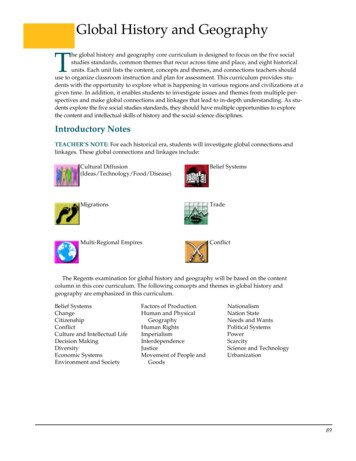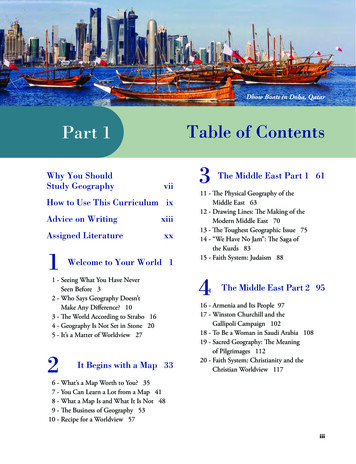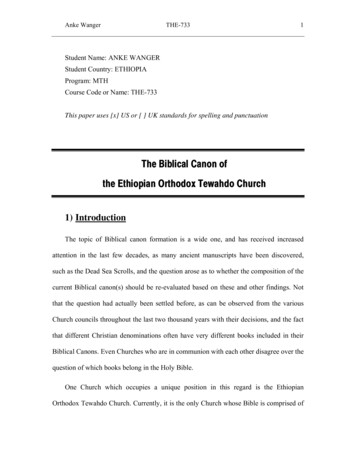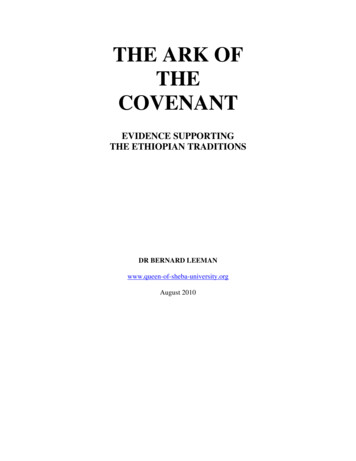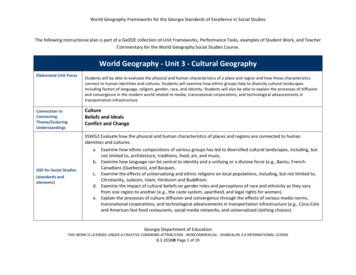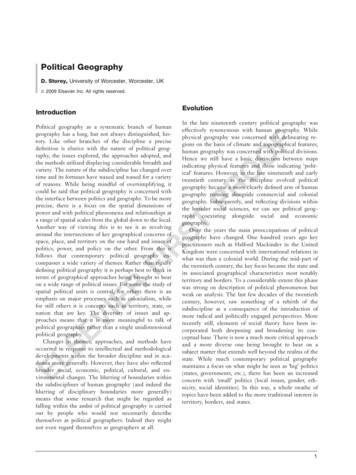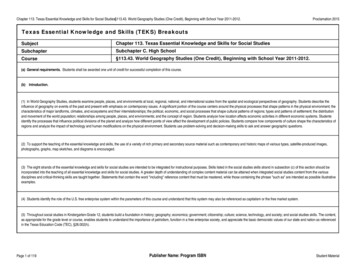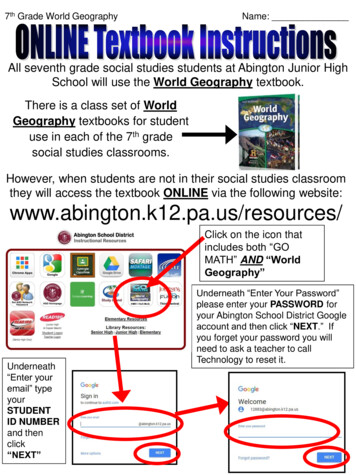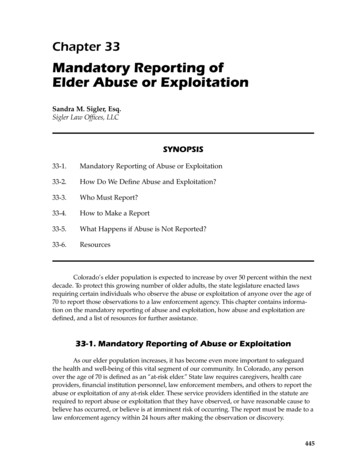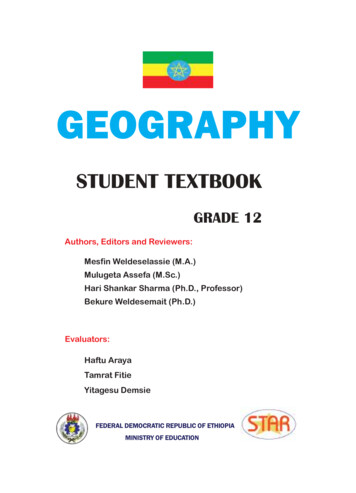
Transcription
GEOGRAPHYSTUDENT TEXTBOOKGRADE 12Authors, Editors and Reviewers:Mesfin Weldeselassie (M.A.)Mulugeta Assefa (M.Sc.)Hari Shankar Sharma (Ph.D., Professor)Bekure Weldesemait (Ph.D.)Evaluators:Haftu ArayaTamrat FitieYitagesu DemsieFEDERAL DEMOCRATIC REPUBLIC OF ETHIOPIAMINISTRY OF EDUCATION
Published E.C. 2003 by the Federal Democratic Republic of Ethiopia, Ministry ofEducation, under the General Education Quality Improvement Project (GEQIP)supported by IDA Credit No. 4535-ET, the Fast Track Initiative Catalytic Fund andthe Governments of Finland, Italy, Netherlands and the United Kingdom. 2011 by the Federal Democratic Republic of Ethiopia, Ministry of Education.All rights reserved. No part of this book may be reproduced, stored in a retrievalsystem or transmitted in any form or by any means including electronic,mechanical, magnetic or other, without prior written permission of the Ministryof Education or licensing in accordance with the Federal Democratic Republicof Ethiopia, Federal Negarit Gazeta, Proclamation No. 410/2004 – Copyright andNeighbouring Rights Protection.The Ministry of Education wishes to thank the many individuals, groups and otherbodies involved – directly and indirectly – in publishing this textbook and theaccompanying teacher guide.Copyrighted materials used by permission of their owners. If you are the owner ofcopyrighted material not cited or improperly cited, please contact with the Ministryof Education, Head Office, Arat Kilo, (PO Box 1367), Addis Ababa, Ethiopia.PHOTO CREDIT: New Complete Geography 1, 1989; Focus on Earth Science 1987; Paul Guinnessand Garrett Nagle, IGCSE Geography, Odder Education, an Hachette UK Company London, 2009;Ralph C. Scott, Physical Geography Second Edition, 1992; Robert J. Sager, William L. Ramsey,Clifford R. Phillips and Frank M. Watenpaugh Modern Earth Science; Simon Ross, IntroducingPhysical Geography and Map Reading, Long Man Group, 1988; Encyclopedia; Microsoft Encarta 2009; http://en.wikipedia.org/wiki.GreatRiftValley; www.uregon.edu,SWWales, UK;http://scienceray.com/earth-sciences/geology; http://geology.about.com/od/geoprocesses.While every attempt has been made to trace and acknowledge copyright, theauthors and publishers apologies for any accidental infringement where copyrighthas proved untraceable.Developed and Printed bySTAR EDUCATIONAL BOOKS DISTRIBUTORS Pvt. Ltd.24/4800, Bharat Ram Road, Daryaganj,New Delhi – 110002, INDIAandASTER NEGA PUBLISHING ENTERPRISEP.O. Box 21073ADDIS ABABA, ETHIOPIASecond Edition 2007 (E.C.),By Tan Prints India Pvt. Ltd.Under GEQIP Contract No. ET-MoE/GEQIP/IDA/ICB/G02/09-A.ISBN 978-99944-2-142-9
ContentsU 1nitProblemsCausesFormingHypothesisPagesBASIC RESEARCH METHODOLOGIES INGEOGRAPHY . 1Data collection,organization .6Definition and Concept . The Significance of Research (qualitative andquantitative) . Approaches of Research . The Nature of Geographic Research . Basic Research Methodology in Geography . Conducting Action Research . FFFFU 2Unit Summary .Review Exercise .335810212525nitMAP USE AND MAP WORK . 282.12.22.32.4The Study of Topographic Maps . 30Globe and Map . 44Map Projection . 47Drawing Sketch Map . 52FFFFUnit Summary .Review Exercise .5858
IIGrade 12 GeographyU 3nitPHYSICAL GEOGRAPHY OF ETHIOPIAAND THE HORN . 603.13.23.33.43.53.6Location of the Horn of Africa and Sizes of MemberCountries . 61Location, Size and Shape of Ethiopia . 65Geological Structure and Relief of theHorn of Africa . 72Climate of Ethiopia and the Horn . 109Natural Vegetation and Wild Animals ofEthiopia . 123Soils of Ethiopia . 138FFFFU 4Unit Summary .Review Exercise .147148nitPOPULATION OF ETHIOPIA ANDTHE HORN . 1494.14.24.34.44.54.64.74.84.9Population Theories . 151Trends of Population Growth and Structurein Ethiopia . 159The Spatial Distribution of Populationin Ethiopia . 168Factors Affecting Population Distributionin Ethiopia . 172Settlement Patterns of Ethiopian Population . 177Determinants of Population Change inEthiopia . 181Impacts of Rapid Population Growthin Ethiopia . 191Population Policy of Ethiopia . 195Urbanization in Ethiopia . 203FFFFContents Contents Unit Summary .Review Exercise .203204
Grade 12 GeographyU 5IIInitECONOMIC GROWTH ANDDEVELOPMENT TREND INETHIOPIA . 2065.15.25.35.45.55.6An Overview of Growth and DevelopmentTrend in Ethiopia . 208Major Features of Ethiopian Economy . 210Present features of Ethiopian socio-economicdevelopment . 215Challenges and Prospects of Socio-economicDevelopment for Ethiopia . 218Economic Relation . 222PASDEP (Plan for Accelerated and SustainedDevelopment to End Poverty) . 226FFFFUnit Summary .229Review Exercise .230Glossary . 233Contents Contents
Problems1UnitCausesFormingHypothesisData collection,organization andinterpretationFindingsSolutionsBASIC RESEARCH METHODOLOGIESIN GEOGRAPHYUnit OutcomesAt the end of this unit, you will be able to:ÞÞ acquire basic research skills to enable you conduct action research;ÞÞ understand the significance of research and its nature in geography; andÞÞ know different approaches used in geographic research.Main Contents1.1 DEFINITION AND CONCEPT1.2 THE SIGNIFICANCE OF RESEARCH1.3 APPROACHES OF RESEARCH (QUANTITATIVE AND QUALITATIVE)1.4 THE NATURE OF GEOGRAPHIC RESEARCH1.5 BASIC RESEARCH METHODOLOGY IN GEOGRAPHY1.6 CONDUCTING ACTION RESEARCHFF Unit SummaryFF Review Exercises
2Grade 12 Geography INTRODUCTIONDo you remember the definitions of geography you learned in previous grades?Geography is a discipline that attempts to understand human and physicalaspects of the world. Its primary concerns are location, time and the concept thateverything that happens to us is affected by our surroundings, including otherpeople and the places within which we live, work and travel. (Khaskar: 1)Geography helps us to understand how the world is changing. By studyinggeography, you will conceive:FF how places and landscapes are formedFF how people and their environments interactFF what decisions we make to further our social interestsFF what causes the diverse range of cultures and societies, and what resultsfrom these.Considering such issues motivates us to:FF formulate questionsFF develop intellectual skills for finding answers (solutions)FF introduce investigative toolsBecause of the wide range of geography’s human and physical concerns, thequestions that arise in its study ultimately lead us to perform research. The goalsof this research include:FF producing definite answers to the questionsFF improving existing answers to the questionsFF performing research that leads to a consensus regarding the answersUnlike the concerns of most social sciences, the social concerns of geographyare relatively dynamic. To provide sustainable solutions for this fast-changingsubject, we must use skilled action research.In this unit you will learn the skills and attitudes that this approach to researchrequires. This information could lead you to become one of tomorrow'sexperienced researchers.Introduction
Unit 1: Basic Research Methodologies In Geography1.1 DEFINITION AND CONCEPT3At the end of this section, you will be able to:ÞÞ explain the concept of research.Key Terms³³ Research³³ Research method³³ Systematic inquiry³³ DiscoveryHave you ever attempted a small research project at your class or section level?The term research came into English fromFF the old French root word “cerchier,” which means to search or seek;andFF the prefix ‘re-’ which means again.Research, therefore, means to seek again with a view to becoming certain. (DestaHamito; 2000)By the term definition, we mean a generally agreed-on opinion about the subjectunder clarification. When we define research it is in this sense. We define researchas a scientific method of investigating answers for the problems identified. Itis also a systematic inquiry into causes or the discovery of new facts throughplanned and organized effort that requires time, money and skill.In short, research is the search for knowledge through objective and systematicmethods of finding solutions to problems.1.2 THE SIGNIFICANCE OF RESEARCHAt the end of this section, you will be able to:ÞÞ show appreciation to the significance of research in tackling socialproblems.Key Terms³³ Development³³ Problem solving³³ Problem identification³³ Rational decisions³³ Policy1.2 The Significance Of Research
4Grade 12 GeographyHave you ever imagined or thought about the importance of research?Development in any country depends, among other things, upon its researchcapability and the extent to which this capability is channeled into action. Also,to result in action, the research must be accessible to appropriate institutions, etc.Sometimes capable research work never reaches its targeted destinations.Advances in science, technology and welfare are often considered to be the resultof capable research. Governments in developed countries allocate huge sums ofmoney for research work. Developing countries are also adopting this approach.This situation has made research work a good business for professionals.Research as a science or professional trade for studying geography:12345678identifies the causes of problems, and the degree or extent of these problems.Example: The occurrences of hunger, flood, epidemics, etc.adds to the body of knowledge about the problem by providing newinformation and knowledge.enables us to visualize or understand the gap between the real world andthe formulated theory.provides a basis for additional investigations that validate the researchfindings or that advance the study of the problem by acquiring more data.widens/enlarges one’s own or a group’s or society's reading and thinkingscope.strengthens our capacity for critical observation and enforces our powerof prediction.enables us to make rational decisions.serves as an aid to formulating policy.Activity 1.1123Can you distinguish the differences between these tasks?FF writing an essayFF writing a reportFF writing up research workAsk your geography teacher and others to tell you about the significance ofresearch.Use the internet to find information about the importance of research.1.2 The Significance Of Research
Unit 1: Basic Research Methodologies In Geography1.3 APPROACHES OF RESEARCH(QUALITATIVE AND QUANTITATIVE)5At the end of this section, you will be able to:ÞÞ use different geographic research approaches in action research.Key Terms³³ Quantitative³³ Qualitative³³ Theory³³ Independent variable³³ Dependent variable³³ Inference³³ Model³³ ApproachWhat do you mean by an approach to treating a problem?There are two basic approaches to research. Their differences are mainly inthe attributes to be measured and the techniques to be used for collecting andanalyzing data. These approaches are calledAAthe quantitative approachBthe qualitative approachQuantitative ApproachWe use the quantitative approach when trying to verify a given geographicaltheory. We translate the concepts of the theory into variables that can be measuredwith statistical techniques.The advantage of this approach is that the quantitative technique employed byone researcher can be used by another researcher for different objectives or forfurther developing the same information. Very simple examples of this approachare given below:FF the decrease in land-lease prices as one travels from the center of a cityto its suburbs;FF the decrease in population density as one travels from the center of acity to its edges;FF the decrease in temperature towards the poles from the equator.All of the preceding examples investigate changes that occur as a function ofdistance from a defined point – for example, from the center of a city. In theexamples, distance is the determining variable. A determining variable influencesthe variation of other phenomena.1.3 Approaches Of Research (qualitative And Quantitative)
6Grade 12 GeographyNoteIn the preceding examples, distance from a center is thedetermining variable. It determines the variation of thesephenomena:ÂÂÂÂÂÂland-lease pricespopulation densitytemperatureIn all of the examples, we assume that any variable that has notbeen mentioned is unchanging (is controlled).The quantitative approach can be subdivided:FF Inferential quantitative approach: the target-study uses an existingdata base and infers characteristics or relationships from it.FF Experimental quantitative approach: the research work manipulatesvariables to see their effects on other variables. This approachrequires considerable control over the research environment in orderto manipulate the determining variables. As described above, distanceis the manipulated variable that affects lease price, population andtemperature.FF Simulation (model) approach: this approach involves constructing anartificial environment (model) to represent the actual environment weare studying. The artificial environment functions in way that parallelsthe actual environment and generates similar information. We use thatinformation to study the phenomena we are investigating.Example:S f (Pm, S1, Cl, etc)This algebraic model simulates the characteristics and development of soilas a system. In the model,S soil,Pm parent materials (rock),S1 slope,Cl climate.The algebraic model explains soil as a function of its parent material, climate andslope.The quantitative approach and hypotheses regarding an existing theory areestablished and tested. Also, mathematical analysis is frequently used.1.3 Approaches Of Research (qualitative And Quantitative)
Unit 1: Basic Research Methodologies In GeographyB7Qualitative ApproachWhat does qualitative method imply in the field of geography?In the qualitative approach, data are used to explain a new theory. No previouslyexisting theory or hypothesis is tested by way of this approach. Quantitativetechniques are not employed. Therefore, the study cannot be repeated by otherresearchers.Common techniques for gathering data in the qualitative approach are:telephone interviewsÂÂ group interviewsin-person interviews (face-to-face)ÂÂ questionnairesÂÂ personal observationsSome examples of subjects that could be studied with the qualitative approach toresearch are:FF differences between urban and rural populations of Ethiopia.FF differences in academic achievement between boys and girls.FF effects of harsh climate on human activity.FF effects of poor leadership on students’ national examination results. Exercise 1.1IComplete the following sentences correctly.1The approach we take to research is a function of the subject or attributesof the study and of the techniques to be used for collecting and analyzingdata. The approaches we choose from are and .2The technique of using interviews and questionnaires in data collectioncomes under the approach.3In the quantitative approach, hypotheses are established and .4If a given theory is not to be verified and no hypothesis about it is to beestablished, the approach employed will be .5To examine the relationship between availability of books and studentgrades in college entrance exam, we would use the approachto research.1.3 Approaches Of Research (qualitative And Quantitative)
Grade 12 Geography8IIVocabulary Skills: See if you can match the items under column A withtheir definitions under column B. Ignore the unrelatable ones.A1To tackle problems2Dynamic3Theory4Critical observation5Attributes6To be DEFGHIJKA tested hypothesis.A proposed idea or explanation that isbased on observed or known facts buthas not yet been proved. A predictivestatement that can be tested.Energetic and fast changing.Simulation of the real world to explaina designed feature.To be proved.Careful observation.Characters.To deal with problems.A document or case that serves as asource or reference.Substances or factors whose effectsare studied.Measures or investigates.1.4 THE NATURE OF GEOGRAPHICRESEARCHAt the end of this section, you will be able to:ÞÞ reflect the distinct nature of geographic research from other disciplines.Key Terms³³ Spatial distribution³³ GIS³³ Spatial dataDo you always focus on the same issue or center of interest?Geography's focus has developed in scope and approach over time through thedevelopment of technology and accumulation of information.Traditionally, geographical research is related to the locations of places and1.4 The Nature Of Geographic Research
Unit 1: Basic Research Methodologies In Geography9people. In the eighteenth century, geography’s focus shifted to the physicaland human characteristics of places in our world. In the mid-twentieth century,geographical research focused mainly on:FF the spatial distributions of phenomena and thingsFF the resulting patterns and interactionsFF the forces responsible for the formation of the patternsVery lately, geographical research has begun to deal with environmental issueslike hunger, global warming, poverty and the sustainable development of ourecosystem.In July of 2006, in Brisbane, Australia, the International Geographical Union(IGU) commission was formed under the UN Charter that commands worldwidegeographical education. The commission’s position is that the academic disciplineof geography is crucial to achieving sustainable worldwide development.Human PopulationHuman population is an issue of concern to geography, sociology, economics,political science, etc. Each discipline has its own concerns and approaches to thisissue. However, the ideas of all these fields of study about population overlap.Economists’ sphere of interest is largely aggregate demand and supply andresponses to production. Sociologists’ research work greatly emphasizes culturalvalues, the effect of the population factor on the occurrence of crimes, harmonydisorders, etc.The concerns of geography and geographers are mainly to:FF assess the spatial distribution of the populationFF determine the forces that governed the distribution:KK is the distribution due to physical factors? orKK is it due to economic factors?FF examine patterns of population distribution: (is it sparsely or denselypopulated, is there uniformity or not?)FF question whether there is a relationship between the distribution andthe factor observed:KK are areas sparsely or densely populated?1.4 The Nature Of Geographic Research
10Grade 12 GeographyKK is there uniformity or not?FF To investigate possible relationships between population distribution andother factors.FF look at the impact of populations on the surrounding natural resourcesFF foreward views on the sustainability of the area or locality for the futureThus, we see the differences and similarities between the various disciplines’approaches to the issue of population and we see geography’s specific concernsand approaches to population.In the 1950s and 1960s, the adoption of quantitative techniques in geographicresearch revolutionized the field. Its interest in human-environment relationsbecame deeper and wider. At the end of the millennium, the development of theGeographical Information system (GIS) produced a powerful investigative toolfor geographic research.Do you know what information sciences are? Please study the next sectioncarefully.Geographic Information System (GIS)The Geographic Information System (GIS) is a computer system that records,stores and analyzes information about features of the earth’s surface. The breakthrough that GIS provided is its ability to generate two-dimensional and threedimensional images of an area. Also, it can receive geographical data from maps,satellites, photographs, and printed texts and books. GIS allows geographers toconduct research on environmental changes. GIS, as an information-acquisitionand interpretation device, has enhanced geographers’ ability to perform accuratehigh-level research. (Encarta, 2007)1.5 BASIC RESEARCH METHODOLOGY INGEOGRAPHYAt the end of this section, you will be able to:ÞÞ use basic elements of research in your action research.1.5 Basic Research Methodology In Geography
Unit 1: Basic Research Methodologies In Geography11Key Terms³³ Research problem³³ Hypothesis³³ Interview³³ Sampling³³ Questionnaire³³ Research report³³ Bibliography³³ Data analysis³³ Primary data³³ Secondary dataCan you distinguish a research method from a research methodology?The following three terms are related to one another, but vary in scope.FF research, research method, and research methodology.A research project is an inquiry into a problem. The researcher’s motivationmight be curiosity or a specific objective. Research is the foundation of researchmethods and methodology. Research results are important guides for solvingmany business, social, academic and other problems.A research method or technique is a skill that uses different steps or elements to solvethe identified problem and arrive at a possible solution. The main methods are:FF the collection and organization of data necessary or related to theproblem.FF the use of statistical parameters to treat and interpret the organizeddata.FF the evaluation of the accuracy of the result obtained.The concept of research methodology is much broader than the former twoconcepts. It is a science that studies how research is done scientifically. Itconsiders:awhy the study is undertaken (its significance at various levels)bhow the research problem is identifiedcwhat assumptions or hypotheses are formulateddwhat type of data are collectedewhy a particular method or technique of analyzing the data is chosenIn short, research methodology has wider dimensions than research methodor technique. It is the philosophy or logic behind the research. Studying basicgeographic research methodology gives you the training you need to acquire theskills below:FF gathering materials and data and arranging them1.5 Basic Research Methodology In Geography
Grade 12 Geography12FF participating in field workFF preparing questionnaires, interviews, etc.FF using statistical techniquesFF interpreting and reporting results of the study that you have designedor proposed.Activity 1.2Form a group and study the following two options for your group work. Choose theone that best suits your school environment and perform the activity.12Ask your teacher to identify some one who is experienced in performingresearch. Invite that person to visit your class and conduct a discussion sessiononawhat research isbthe significance of researchcthe relevance of research for geographyUsing Encarta or Internet or other possibly accessible materials, conduct agroup discussion inferring the different concepts stated between a researchtechnique and a research methodology.NoteResearch is a time, money and other costs consuming activitybut empowers you to understand, be logical and be a goodobserver.Basic Elements of ResearchAfter considering basic questions of the research methodology for their projects,geographers conduct their research by performing the following tasks:FF identifying or formulating the research problemFF defining the significance of the study for solving the problem1.5 Basic Research Methodology In Geography
Unit 1: Basic Research Methodologies In Geography13FF defining the study of the problem areaFF defining the objectives of the studyFF defining the scope and limitations of the studyFF reviewing the literatureFF developing a working hypothesisFF preparing the research designFF defining the sample designFF collecting and organizing the dataFF analyzing the data by using statistical techniquesFF generalizing and interpreting the dataFF preparing the research report, based on the findingsFF compiling the bibliography/referencesIn what follows, we look at these elements:AIdentifying or Formulating the Research ProblemAt the very beginning of a research project, the researcher must choose theproblem to study. In other words, the researcher must define the area of interest.A good approach to defining a research problem is to discuss it with people whohave significant experience performing research in the study area and to read theliterature related to that area.Investigating the causes of a problem is an important factor for identifying itssolutions. In some cases, a problem has multiple causes that you must identify.BDefining the significance of the study for Solving theproblemThe significance of a research project differs from its objectives. Its significanceis its importance at a local, regional, national or global level.To be significant, a study must benefit a society or community by:FF providing new discoveriesFF improving existing situationsFF demanding new decisionsFF enriching or refuting already existing theories1.5 Basic Research Methodology In Geography
14CGrade 12 GeographyStudying the Problem AreaWhen we study the problem area that a research project addresses, we create adetailed bird's eye-view for ourselves and others who will access the research.As we study the problem area, we identify problems and eliminate ambiguity.This step is particularly important when we research the spatial distribution ofphenomena and things.DDefining the Objectives of the StudyA study’s objectives are the goals the researcher intends to achieve through theresearch project. In this step, general and specific objectives are set. The generalobjectives provide short statements of the goal, while the specific objectivesprovide detailed inter-connected statements.EDefining the Scope and Delimitation of the StudyResearch requires time, financing and skilled manpower or professionals. Thesefactors are not always available at required levels. Shortages of these resourceslimits the spatial dimension that the research can cover. It also limits the qualityof the research work. The greater the accessibility or spatial extent, the wider isthe scope and the amount and quality of information to be obtained; which, inturn, leads to greater competency.FReviewing the LiteratureDid you have the experience of reviewing books? After reviewing, you mayhave the main idea. Try to remember that idea.Reviewing the literature means identifying, reading and analyzing documentationrelated to the research you plan to perform. For example,FF booksFF academic journalsFF conference proceedingsFF government reportsFF published and unpublished documents related to the problemFor quantitative research, the literature review can help you identify the variablesand their relationships. You need to understand them in order to establish anappropriate hypothesis.1.5 Basic Research Methodology In Geography
Unit 1: Basic Research Methodologies In Geography15For qualitative research, the literature review helps you to expand your knowledgeof the research subject.GDeveloping or Formulating a Working HypothesisHow do we develop a working hypothesis?A hypothesis is a preliminary assumption or tentative explanation that accountsfor a set of facts, taken to be true for the purpose of investigation and testing atheory.Establishing a working hypothesis is crucial for research in all disciplinesincluding geography. The information you gain from your literature review willhelp you to formulate an appropriate hypothesis.The hypothesis you develop will guide you as you define the types of data tocollect and decide which methods of data analysis you will use.A working hypothesis can be formulated based on the ideas you gather from:aconducting discussions with experts,binferring from the work of others on similar studies,cpersonal investigations of conducting original field interviews withinterested parties and individuals.A hypothesis must have the following characteristics. Itashould be clear and preciseHbshould be capable of being tested or verifiedcshould state relationships between the variables determineddmust explain the facts that give rise to the explanationPreparing the Research DesignWhat is the basis for preparing a research design?After formulating the research problem, you prepare a research design. Theresearch design is the conceptual framework within which the research couldbe conducted. It helps you colle
Unit Outcomes At the end of this unit, you will be able to: Þ acquire basic research skills to enable you conduct action research; Þ understand the significance of research and its nature in geography; and Þ know different approaches used in geographic research. Main Contents 1.1 DEFINITION AND CONCEPT 1.2 THE SIGNIFICANCE OF RESEARCH 1.3 APPROACHES OF RESEARCH (QUANTITATIVE AND QUALITATIVE)
